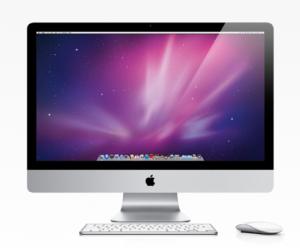Apple Wins Patent for NFC Antenna in Computer Display

While doubts continue to grow that the next iPhone will support NFC, Apple has been granted a patent for incorporating an NFC antenna into the display of its iMac desktop computers and potentially other devices.
The patent, granted by the U.S. Patent and Trademark Office and reported by Patently Apple Tuesday, appears to have security as its main application.
The iMac desktop computer monitor illustrated in the patent could read information–such as an employee credential–stored on a portable NFC-enabled or contactless device, which could be an iPhone, iPod or even key fob or smart card. The iMac would likely be acting in peer-to-peer or card emulation mode to read the data from the portable security token.
According to Patently Apple, the iMac could be set up in a restricted area of a building or a reception desk, even a merchant outlet. It would not control door access, but perhaps could provide a secondary level of authentication for employees or visitors.
For example, if the iMac is at a reception desk, a receptionist could “visually monitor visitors to an organization as they bring the portable device” into communication with the computer, the patent from Apple reportedly states.
But the patent is not limited to the iMac and could include other devices, including MacBook laptops, along with routers, kiosks, POS terminals, medical equipment, media players, and other handheld devices, Patently Apple reports. But it does not specifically refer to incorporating NFC in iPhones.
Einar Rosenberg, CTO of U.S.-based NFC application provider Narian Technologies, who watches Apple’s numerous NFC patent requests closely, said he believes this patent fits into Apple’s larger plans for NFC.
“Everybody has been focused on the iPhone for NFC, but people forget that NFC is going to be in a variety of devices,” he said.
Apple through its patent requests has expressed an interest in using NFC for pairing and sharing of content and settings among its various devices. Most of the requests have focused on the iPhone as a sort of hub for this sharing network.
But Rosenberg notes that security is an important part of sharing content, and Apple might have plans to one day use NFC to help secure its forthcoming iCloud service, which would store the music, photos, apps, calendars, documents and other content of a given user on Apple’s servers and would then push them wirelessly to all of the devices of the user.
“One of the biggest issues with iCloud is security,” he said. “You are using a username and password to access iCloud. Using something like NFC makes iCloud much more secure.”
For its patent integrating an NFC antenna into a Mac computer display or other devices, it remains unclear what type of security Apple has in mind for NFC.
Also, while this patent was actually granted, Apple has filed many more patent requests with the Patent and Trademark Office the past few years, most involving the iPhone. But the company has yet to incorporate NFC into a single device.
Most experts doubt Apple will support NFC in the iPhone 5 or whatever it calls its next-generation smartphone, due out later this year.
The experts, including analysts who have talked to NFC chip makers, believe Apple will wait until the following iPhone generation, expected in 2012, to adopt NFC.
Among the theories explaining why Apple would pass on the technology this year is that the company does not believe the NFC infrastructure and the technology itself is mature enough to yield the polished user experience that it seeks to offer customers.












